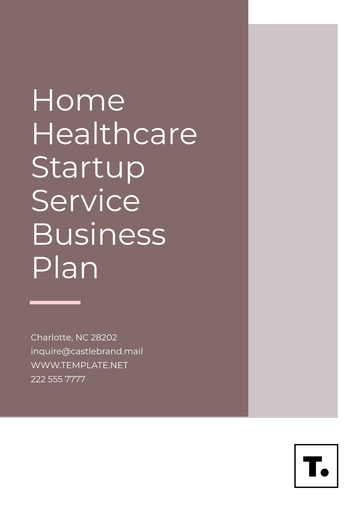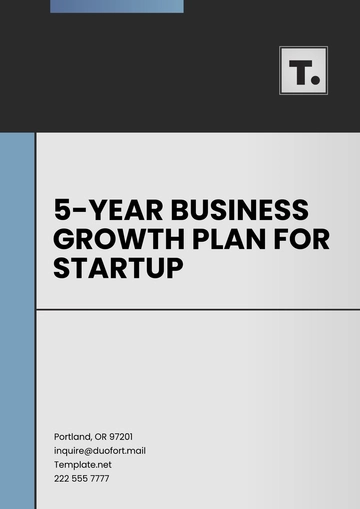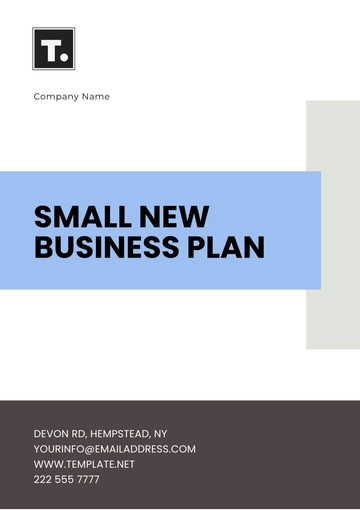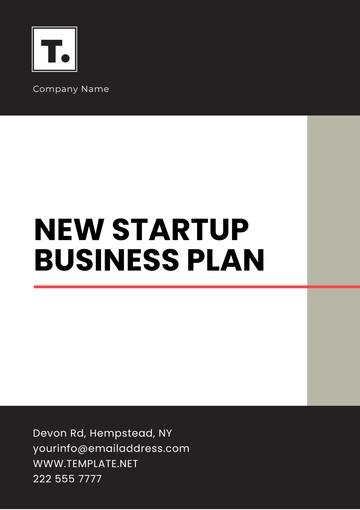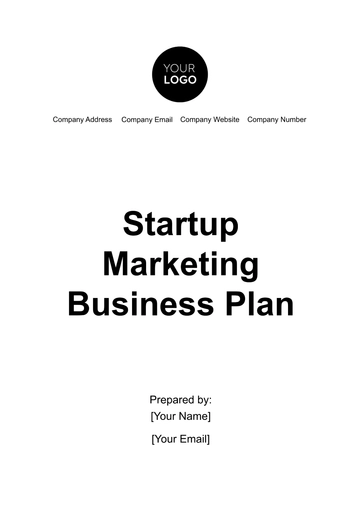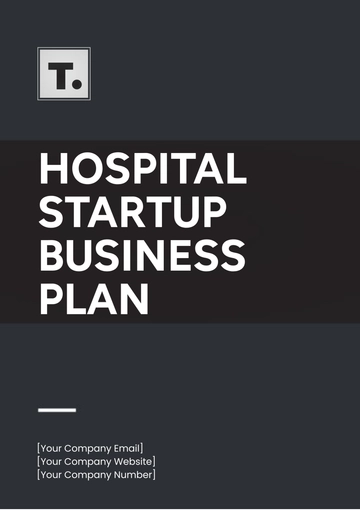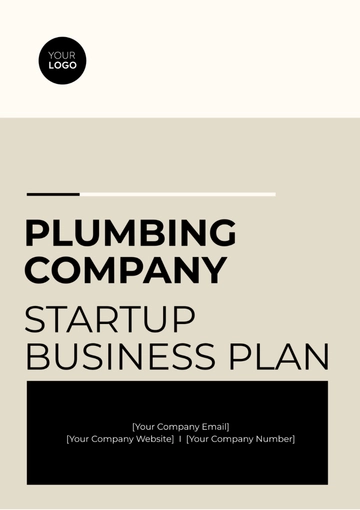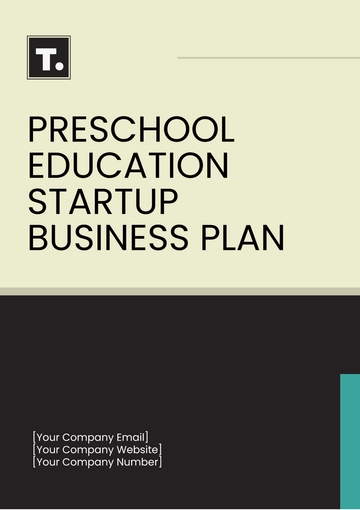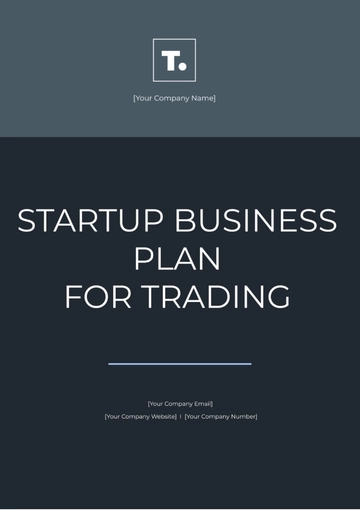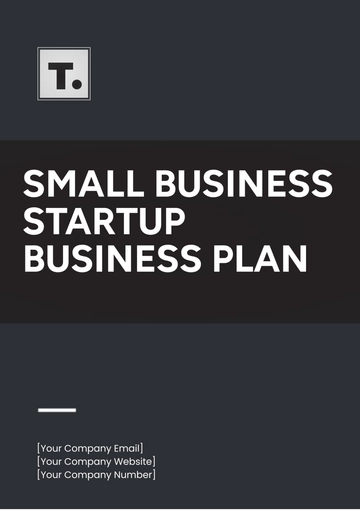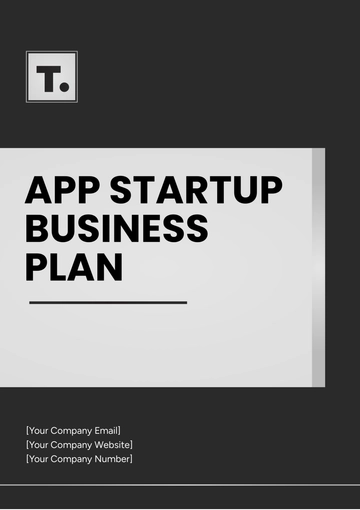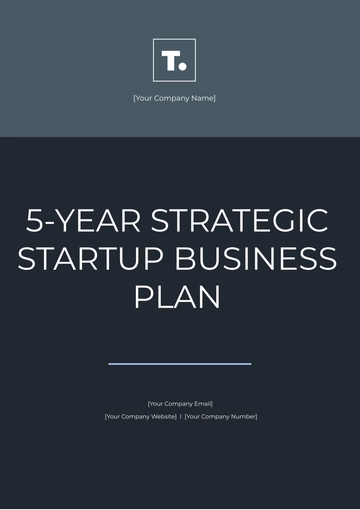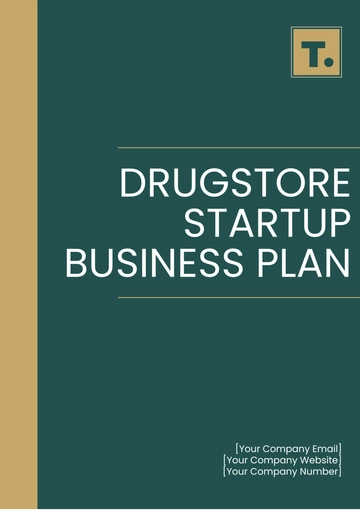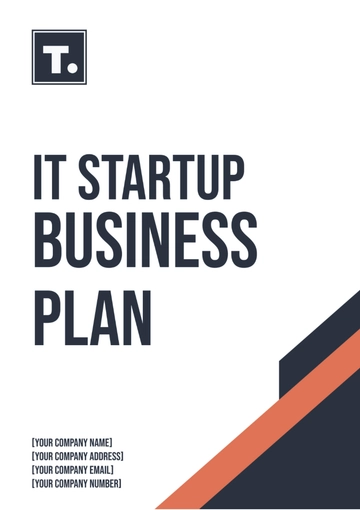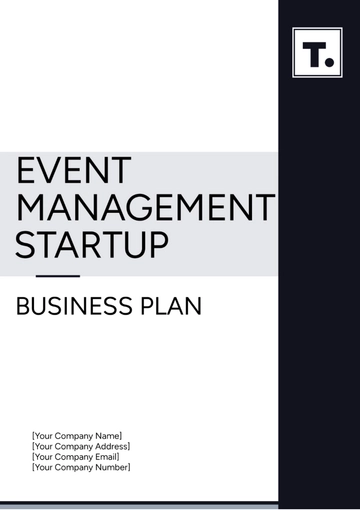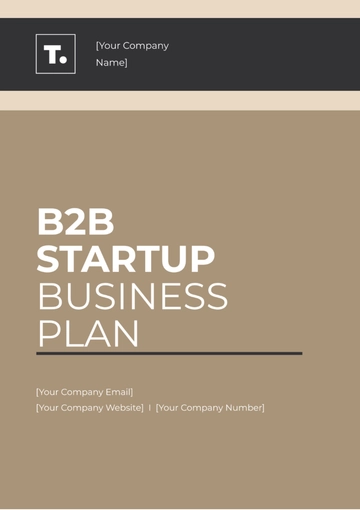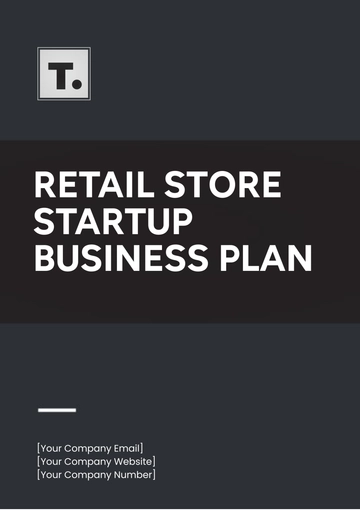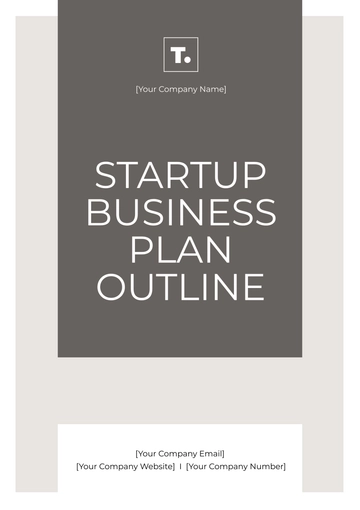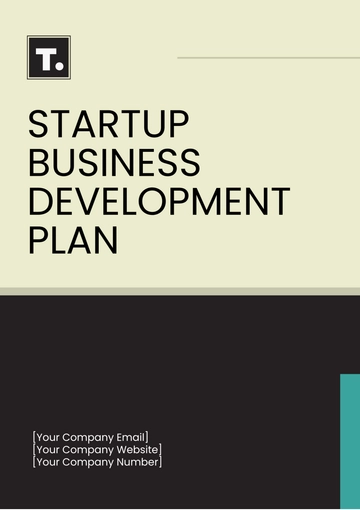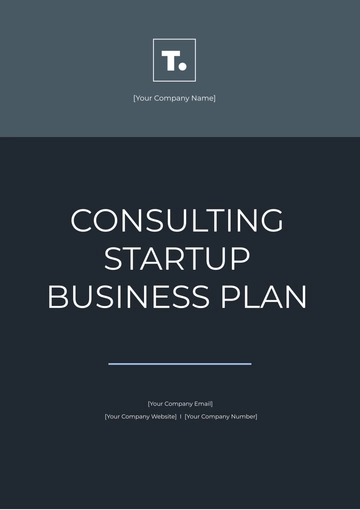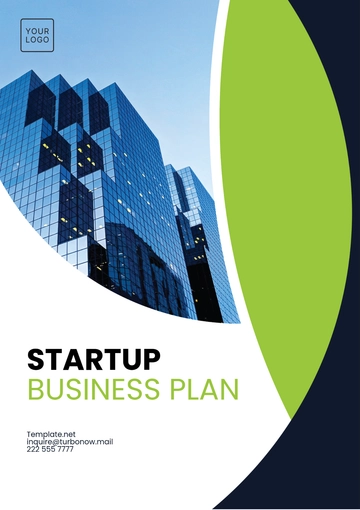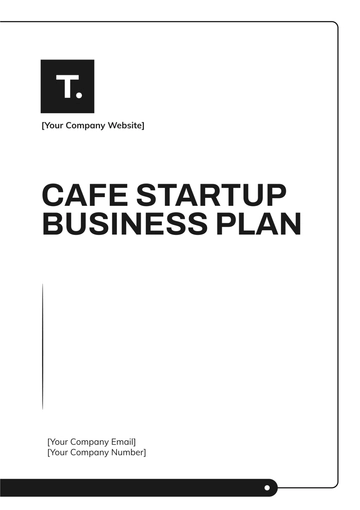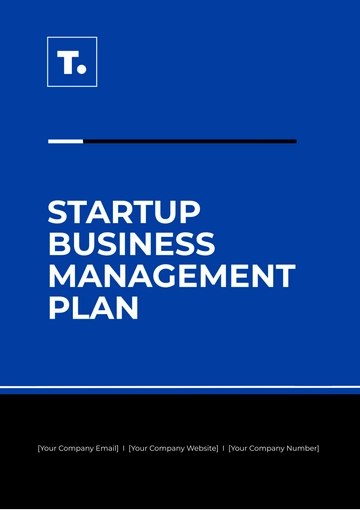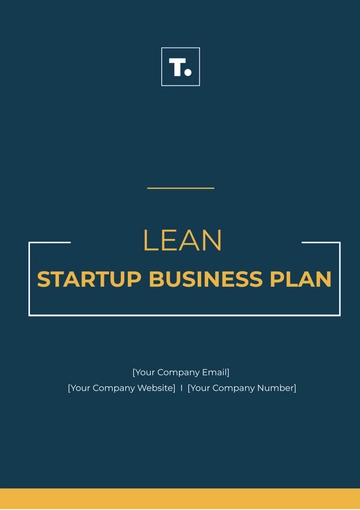Free Startup Business Operations Plan

1. Executive Summary
Our startup is primed for success with a holistic business operations plan designed to foster innovation, operational excellence, and enduring growth. At the core of our strategy is a robust operational plan that intricately details processes, from production and distribution to customer support and quality assurance. This foundational framework ensures the seamless execution of day-to-day activities, establishing a strong operational backbone for exceptional service delivery.
Strategically securing funding is paramount to our journey. We seek an initial seed investment to propel crucial aspects such as product development, market research, and team expansion. Looking ahead, our anticipated Series A Funding is earmarked for scaling operations, executing strategic marketing initiatives, and incorporating vital technology upgrades. This comprehensive funding plan underscores our commitment to establishing a resilient foundation for long-term success.
Complementing our operational and financial strategies is a dynamic marketing and sales approach. From crafting a compelling brand identity to implementing diverse marketing channels and a streamlined sales process, our strategy aims at effective customer acquisition, retention, and satisfaction. Our commitment to performance excellence is evident in our meticulous monitoring of key metrics across financial performance, customer satisfaction, employee productivity, product quality, operational efficiency, and technology performance. This holistic strategy positions our startup for success in a competitive business landscape, aligning with our overarching goal of achieving sustainable growth and delivering exceptional value to our customers.
2. Market Analysis
2.1 Industry Overview
2.1.1 Industry Size and Growth Rate
The tech industry, valued at an impressive $6 trillion, continues to demonstrate resilience with a projected annual growth rate of 8%. This substantial market size and consistent growth create a fertile ground for our startup to not only enter but thrive in the dynamic and ever-evolving tech landscape.
2.1.2 Major Competitors
Among the major competitors in the tech industry are globally recognized corporations known for their prowess in technological innovation, extensive market reach, and diverse product portfolios. Analyzing their strategies provides valuable insights as we position ourselves in this competitive environment.
2.1.3 Buyer Behavior
Understanding buyer behavior is pivotal in the tech industry. Consumers increasingly prioritize cutting-edge solutions, seamless user experiences, and a growing emphasis on sustainability. Our startup aims to tailor offerings to align with these preferences, creating a competitive edge in the market.
2.1.4 Market Trends
Current market trends reveal a surge in demand for artificial intelligence applications, widespread adoption of cloud services, and an intensified focus on cybersecurity. Our startup plans to leverage these trends, offering innovative solutions that address emerging needs and stay at the forefront of industry developments.
2.2 Opportunity and Threat Analysis
2.2.1 Emerging Opportunities
Within the tech sector, emerging opportunities lie in the realm of quantum computing, the Internet of Things (IoT), and a heightened demand for environmentally sustainable technologies. Our startup is poised to explore and capitalize on these opportunities, positioning itself as a pioneer in cutting-edge tech solutions.
2.2.2 Potential Threats
The tech landscape is not without challenges, including potential regulatory changes, economic fluctuations, and cybersecurity risks. To navigate these threats effectively, our startup will develop robust contingency plans, ensuring adaptability and resilience in the face of uncertainties.
2.2.3 Competitive Positioning
Our competitive positioning strategy hinges on a commitment to continuous innovation, a focus on user-centric design principles, and a steadfast dedication to sustainability. By emphasizing these factors, our startup aims to carve a distinctive niche in the competitive tech market, resonating with discerning consumers.
2.3 Market Segmentation
2.3.1 Target Customer Profiles
Our target customer base spans tech-savvy millennials, businesses seeking digital transformation, and environmentally conscious organizations. Deep insights into their preferences will guide the development of products and services that cater to specific needs, fostering customer loyalty.
2.3.2 Market Penetration Strategies
To effectively penetrate the market, our startup will employ a multi-faceted approach. This includes leveraging online platforms, forming strategic partnerships, and deploying targeted digital advertising campaigns. Flexible pricing models will ensure accessibility across diverse customer segments.
2.4 Regulatory Landscape
2.4.1 Environmental Standards Compliance
Our commitment to environmental standards involves implementing sustainable practices across the entire tech manufacturing process. This encompasses eco-friendly material sourcing, energy-efficient data centers, and responsible waste management.
2.4.2 Data Protection and Privacy
Compliance with data protection laws is paramount. Our startup will invest in state-of-the-art data security measures, transparent privacy policies, and user education initiatives. Obtaining explicit user consent for data usage ensures a trust-centric relationship.
2.4.3 Fair Trade Practices
Ethical sourcing and fair trade practices are integral to our startup's values. We will maintain transparent relationships with suppliers, ensuring fair compensation and ethical sourcing of materials for tech production, contributing to a sustainable and socially responsible tech industry.
3. Organizational Structure
The organizational structure is designed to foster efficiency, innovation, and accountability. Each team member plays a crucial role in achieving our startup's operational objectives.
3.1. Leadership Team
The leadership team oversees strategic decision-making, stakeholder management, and the overall direction of the company.
Role | Responsibilities |
|---|---|
CEO | Strategic Leadership, Decision-making, Stakeholder Management |
COO | Operational Oversight, Process Optimization, Resource Management |
CFO | Financial Strategy, Budgeting, Investor Relations |
3.2 Operations Team
The operations team is responsible for day-to-day activities, ensuring smooth processes and efficient resource utilization.
Role | Responsibilities |
|---|---|
Operations Manager | Day-to-day Operations, Process Optimization, Resource Management |
Project Manager | Project Planning, Execution, Team Coordination |
Logistics Coordinator | Supply Chain Management, Distribution Oversight |
3.3 Marketing and Sales Team
The marketing and sales team focuses on attracting and retaining customers through effective branding, positioning, and sales strategies.
Role | Responsibilities |
|---|---|
Marketing Manager | Branding, Marketing Strategies, Customer Acquisition |
Sales Representative | Sales Process, Client Relationship Management, Revenue Generation |
These roles and responsibilities are strategically structured to form a cohesive and agile organizational framework. The leadership team, led by the CEO, guides the company's overarching strategy, ensuring alignment with business objectives. The operations team, under the Operations Manager, is dedicated to the seamless execution of day-to-day activities, optimizing processes, and efficiently managing resources. The marketing and sales team, overseen by the Marketing Manager, is focused on creating a strong market presence through effective branding, innovative marketing strategies, and customer acquisition. Each team member brings a unique skill set and experience to their respective roles, contributing to the overall success of our startup. This organizational structure is designed to foster collaboration, innovation, and a customer-centric approach as we navigate the dynamic landscape of our industry.
4. Product Line and Services
The success of our startup is intricately tied to the innovation and value proposition inherent in our product line and services. The table below provides a comprehensive overview of the offerings that will define our market presence:
Product/Service | Description | Key Features | Pricing |
|---|---|---|---|
Innovative Software | Cutting-edge software solution designed to streamline business operations, enhance productivity, and facilitate seamless collaboration. | AI-powered analytics, real-time data insights, and cloud integration. | $49.99 per user/month |
Detailing our product line and services provides a clear and comprehensive understanding of what sets our startup apart in the market. It serves as the foundation for our value proposition, demonstrating to stakeholders, investors, and customers the unique solutions we bring to address their needs. Our flagship product is a cutting-edge software solution. This software is not merely a tool but an innovation designed to revolutionize how businesses operate. With a focus on streamlining operations and boosting productivity, the software integrates advanced AI-powered analytics, providing users with real-time data insights. Additionally, its cloud integration ensures accessibility and scalability. Priced at $49.99 per user per month, this product is positioned competitively in the market, offering exceptional value for businesses seeking operational efficiency.
5. Marketing & Sales Strategy
Our marketing and sales strategy is meticulously designed to attract and retain customers while positioning our startup for sustainable growth.
5.1 Branding and Positioning
5.1.1 Brand Identity
Developing a strong brand identity is paramount to our success. This includes crafting a compelling brand story, defining our unique value proposition, and creating a visual identity that resonates with our target audience.
5.1.2 Positioning Strategy
Our positioning strategy revolves around differentiating our offerings from competitors. Emphasizing our commitment to innovation, sustainability, and customer-centricity, we aim to carve a distinctive niche in the market.
5.2 Marketing Channels
5.2.1 Digital Marketing
Harnessing the power of digital marketing is integral to our outreach. This includes targeted social media campaigns, search engine optimization (SEO), and email marketing to engage our audience and drive brand awareness.
5.2.2 Traditional Marketing
Supplementing our digital efforts, traditional marketing channels such as print media and industry events will be leveraged to reach a diverse audience and establish a comprehensive brand presence.
5.3 Sales Process
5.3.1 Customer Journey Mapping
Understanding the customer journey is key to designing an effective sales process. By mapping out touchpoints from awareness to purchase, we ensure a seamless and engaging experience for potential customers.
5.3.2 Sales Team Training
Our sales team will undergo comprehensive training to effectively communicate our value proposition, address customer needs, and navigate the sales process with agility and professionalism.
5.4 Customer Relationship Management (CRM)
5.4.1 CRM Implementation
Implementing a robust CRM system is essential for managing customer interactions. This includes tracking leads, monitoring customer preferences, and ensuring personalized communication to enhance customer satisfaction.
5.4.2 Customer Feedback Loop
Establishing a continuous feedback loop allows us to gather insights from customers, identify areas for improvement, and adapt our strategies to meet evolving market demands.
6. Operational Plan
A robust operational plan is essential for the day-to-day activities that drive our startup's success. The table below outlines key operational processes and activities to ensure seamless functioning, minimizing disruptions, and maintaining exceptional service delivery.
Process | Responsible Team | Timeline |
|---|---|---|
Production | Operations Team | Ongoing |
Distribution | Logistics Coordinator | As per orders |
Customer Support | Customer Support Team | Ongoing |
Quality Assurance | Operations Team | Ongoing |
Production: The production process involves the manufacturing of our innovative software and hardware products. Led by the Operations Team, this ongoing process adheres to stringent quality standards and efficient production schedules, ensuring the timely delivery of high-quality products.
Distribution: The logistics coordination process is spearheaded by the Logistics Coordinator. It ensures the timely and efficient distribution of products to customers and partners based on incoming orders. This process is flexible, aligning with the demand and order fulfillment requirements.
Customer Support: Ensuring customer satisfaction is the responsibility of the Customer Support Team. Through ongoing efforts, they address queries and promptly resolve issues, fostering positive customer experiences and building lasting relationships.
Quality Assurance: To maintain high product standards, the Operations Team conducts rigorous quality checks at each stage of the production process. This ongoing process guarantees that our products meet and exceed the expectations of our customers.
The operational plan is a linchpin in the success of our startup, ensuring that day-to-day activities are executed with precision and efficiency. Production and distribution processes are structured to meet demand while upholding quality standards. Our dedicated customer support team plays a pivotal role in maintaining positive customer relationships, addressing concerns promptly. Quality assurance measures are embedded at every stage of production, guaranteeing that our products consistently meet the highest standards. This comprehensive operational plan not only guarantees operational excellence but also contributes to our overarching goal of delivering exceptional service and building a strong foundation for sustained growth.
7. Funding
Securing adequate funding is pivotal for our startup's growth and sustainability. The graph below outlines the funding details, including the amount requested and the intended use of funds:
Initial Seed Funding ($2,000,000): This crucial injection of $2,000,000 in Initial Seed Funding is strategically allocated to lay the groundwork for our startup. A significant portion will be devoted to product development, ensuring we bring cutting-edge software and hardware solutions to market. Additionally, a substantial investment in market research will provide invaluable insights, guiding our strategies for market penetration. Team expansion is prioritized, allowing us to assemble a skilled workforce capable of executing our vision and propelling our startup into a position of strength within the industry.
Series A Funding (Projected $10,000,000): The anticipated Series A Funding of $10,000,000 represents a pivotal milestone in our growth trajectory. The primary focus is on scaling operations to meet escalating demand for our innovative products. A substantial portion of the funding is earmarked for strategic marketing initiatives, aiming to bolster brand visibility and drive customer acquisition. The infusion of capital into technology upgrades ensures our offerings remain at the forefront of innovation, positioning our startup as a key player in the dynamic landscape of the tech industry.
The funding plan serves as a strategic roadmap, ensuring that each dollar invested contributes to our startup's overarching goals. The Initial Seed Funding jumpstarts our journey, laying the foundation for a robust product portfolio, deep market understanding, and a skilled team. Looking ahead, the Series A Funding represents a critical phase where we leverage resources to scale operations, enhance market presence, and sustain our commitment to technological excellence. The total funding requested, amounting to $12,000,000, reflects a comprehensive approach to securing the capital necessary for our startup's success in a competitive business landscape.
8. Performance Metrics
Performance metrics play a crucial role in evaluating and enhancing our startup's success across various operational dimensions. The following provides an in-depth breakdown of key metrics and their significance.
8.1 Financial Performance Metrics
8.1.1 Revenue Growth
Monitoring revenue growth is critical for assessing the trajectory of our financial success. This metric tracks the percentage increase in overall revenue over specific periods, providing insights into the effectiveness of our sales and marketing strategies. A consistent upward trend in revenue growth signifies market acceptance and revenue-generating potential.
8.1.2 Profit Margins
Examining profit margins is essential for evaluating the efficiency of our cost management strategies. This metric calculates the ratio of profit to revenue, helping us understand the sustainability of our business model. Healthy profit margins indicate effective cost control, ensuring that our operational expenses align with revenue generation.
8.1.3 Return on Investment (ROI)
ROI measures the return on our investment efforts. By assessing the profitability of our initiatives relative to the resources invested, we gauge the efficiency and effectiveness of our overall investment strategy, guiding future decision-making.
8.2 Customer Satisfaction Metrics
8.2.1 Net Promoter Score (NPS)
NPS is a pivotal metric for measuring customer satisfaction and loyalty. By understanding how likely customers are to recommend our products, we gain valuable insights into overall satisfaction levels. A high NPS indicates strong customer advocacy and positive brand perception.
8.2.2 Customer Retention Rate
Tracking the customer retention rate provides a comprehensive view of our ability to maintain and nurture long-term customer relationships. This metric assesses customer loyalty and satisfaction, essential factors for sustainable growth and recurring revenue.
8.2.3 Customer Feedback Effectiveness
Effectively leveraging customer feedback is crucial. This metric evaluates the responsiveness and efficiency of our feedback loop, ensuring that customer insights are actively utilized for continuous improvement and innovation.
8.3 Employee Productivity Metrics
8.3.1 Revenue per Employee
Measuring revenue generated per employee reflects the efficiency and productivity of our workforce. This metric indicates how effectively our team contributes to revenue generation, guiding workforce optimization strategies.
8.3.2 Employee Satisfaction Index
A content and motivated workforce are vital for sustained success. The Employee Satisfaction Index assesses overall employee happiness, engagement, and work environment, impacting overall team performance and productivity.
8.3.3 Employee Training and Development Impact
Evaluating the impact of training and development initiatives on employee performance ensures continuous skill enhancement and adaptation to evolving industry demands.
8.4 Product Quality Metrics
8.4.1 Defect Rate
Maintaining high product quality is paramount. The Defect Rate metric measures the percentage of products with defects, ensuring that our offerings consistently meet or exceed customer expectations.
8.4.2 Customer Complaint Resolution Time
Efficiently resolving customer complaints is a key aspect of product quality management. This metric tracks the time taken to address and resolve customer issues, directly impacting overall customer satisfaction.
8.4.3 Product Improvement Cycle Time
Assessing the cycle time for implementing product improvements ensures agility and responsiveness to market feedback, allowing us to enhance our offerings in a timely manner.
8.5 Operational Efficiency Metrics
8.5.1 Cycle Time
Reducing cycle time in operational processes enhances efficiency. This metric measures the time taken for processes to be completed, guiding efforts to streamline operations and improve overall responsiveness.
8.5.2 Resource Utilization
Optimizing resource utilization ensures effective allocation and minimizes waste. This metric evaluates the efficiency of resource deployment, guiding strategies to enhance overall operational effectiveness.
8.5.3 Process Automation Impact
Assessing the impact of process automation on operational efficiency ensures that automation initiatives contribute to streamlined processes and reduced manual intervention.
8.6 Technology Performance Metrics
8.6.1 System Uptime
For a technology-focused startup, ensuring high system uptime is crucial. This metric measures the percentage of time our digital platforms are operational, ensuring reliability and a seamless user experience.
8.6.2 Response Time
Tracking the response time of our digital platforms is vital for user satisfaction. This metric measures the time it takes for systems to respond to user interactions, guiding efforts to maintain optimal performance.
8.6.3 Technology Scalability
Evaluating the scalability of our technology infrastructure ensures that it can accommodate growing user demand and evolving business requirements, supporting long-term growth.
- 100% Customizable, free editor
- Access 1 Million+ Templates, photo’s & graphics
- Download or share as a template
- Click and replace photos, graphics, text, backgrounds
- Resize, crop, AI write & more
- Access advanced editor
Streamline operations easily with the editable Startup Business Operations Plan Template on Template.net! This customizable plan ensures a comprehensive approach to day-to-day business functions. Utilize the AI Editor Tool to align the plan with your startup's operational requirements, whether at the initial planning stage or modifying operational strategies! Access now!
You may also like
- One Page Business Plan
- Coffee Shop Business Plan
- Restaurant Business Plan
- Food Business Plan
- Real Estate Business Plan
- Executive Summary Business Plan
- Cover Page Business Plan
- Nonprofit Business Plan
- Daycare Business Plan
- Construction Business Plan
- Startup Business Plan
- Medical Business Plan
- Bakery Business Plan
- Service Plan
- Hotel Business Plan
- Catering Business Plan
- School Business Plan
- Healthcare Business Plan
- Transportation Plan
- Sports Plan
- Car Wash Business Plan
- Salon Business Plan
- Clothing Business Plan
- Farming Business Plan
- Boutique Plan


